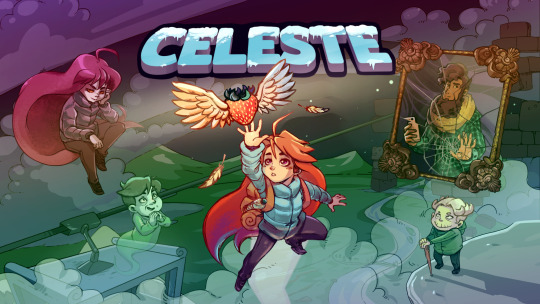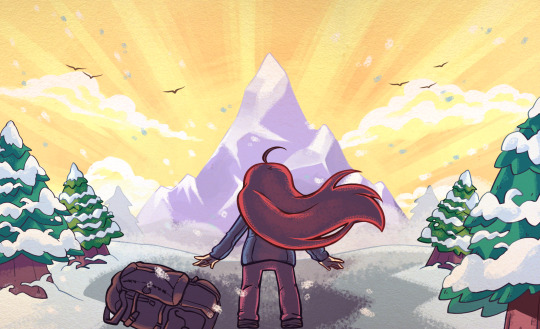#also not me posting a drawing of Strawberri then immediately changing parts of her design in my next drawing... smh
Text

HAPPY BIRTHDAY @businesstiger !!! U R OLDER NOW!!!!!!! YIPPEE
#my art#digital art#oc art#my oc's#not my oc's#me and my awful tagging systems heart eyes emoji#missy#strawberri#furry art#birthday art#also not me posting a drawing of Strawberri then immediately changing parts of her design in my next drawing... smh
25 notes
·
View notes
Text
Stew Reviews - Celeste

So, after a full year of umming and erring over it, I finally gave in to peer pressure and got myself a Nintendo Switch. I’ve got the usual no-brainer titles to go with it; Mario Kart and Odyssey, Skyrim, Breath of the Wild, Rayman Legends, and The Binding of Isaac, curiously enough. But out of all the games I’ve played on this new system, the one that most cried out for analysis was a little indie project from Matt Thorson by the name of Celeste that Nintendo seem to be particularly eager to push.
I didn’t pick up Celeste immediately because from the gameplay trailer I had assumed it to be a slightly generic platformer. When I did pick it up a few days later, I found that mechanically, Celeste can be considered a contemporary of Super Meat Boy which I really like, being a tough-but-fair 2D pixel art precision platformer in the try-die-try-again mould. The gameplay isn’t particularly revolutionary, so I guess in a way I was right about it looking generic, but it is very solid and rarely unduly frustrating. The main innovation here is that you collect strawberries rather than bandages, and your basic move set is enhanced with the ability to climb walls and a short directional dash which you can use to quickly reposition yourself in mid-air. The physics are reliable and the platforming puzzles are all competently designed, being built around the dashing and climbing mechanics, so they always feel central and never like some gimmicky tag-on. Thusly, navigating a screen on the first attempt with a smoothly rattled off sequence of calculated jumps gives a feeling of indescribable satisfaction. Each level is visually distinct and has its own slight variations on platforming mechanics, such as dash extenders or trajectory-altering winds, so the game retains a stable core that doesn’t end up becoming stale. The game suggests that gathering the strawberries is completely optional and in the end grants little more than bragging rights, but it’s entertaining enough that I generally want to go after them while still being challenging without making me break the Switch into three pieces – not in the sense that it’s meant to, I mean – which few games can claim to achieve. There are also secrets to find, B-sides and crystal hearts, and admittedly their function isn’t readily apparent until you reach post game, but they do have one so they count towards something other than meaningless 100% completion. As satisfactory as this all is however, where Celeste really grabbed me was in the story.

Some minor spoilers ahead for the sake of analysis, so you may want to skip the next two paragraphs if you want to go into Celeste fresh.
You play as Madeline – assuming you decided not to abuse the enter-name-here feature – a young red-headed woman who has arrived at the foot of Mount Celeste with the intent to climb to the mountain’s summit. Right off the bat it’s quite obvious that Madeline is dealing with some deep-seated emotional issues, from the way she stubbornly proclaims how much she needs to reach the summit and the occasional cryptic dialogue exchange or dream sequence. One conversation in particular flat out states that she suffers from panic attacks, so presumably it’s some form of anxiety disorder. The thrust of all this is that climbing Mount Celeste serves as a metaphor for Madeline overcoming her problems, which as a writer and as someone who has experienced mental health issues myself, I can appreciate. It might not be the most complex piece of symbolism in the world, but it works and it works well. This theming is complemented by the gameplay itself too in a nice example of ludo-narrative synchronicity, as in the face of your literally hundreds upon hundreds of failed attempts, only your own determination not to give up can propel you onwards.
As you draw closer to the peak, you’ll meet and interact with various supporting characters. They’re all quite reliably grounded and likeable, and each of them strike a chord in different ways. First off is Theo, let’s call him our frame of reference as the most “normal” person in the story; a wanderlusting and aimless amateur photographer who’s also climbing the mountain, occasionally slightly brusque in his manner but also pragmatic and sensible with it. Then there’s a portly and spectacularly neurotic hotel owner who may or may not be dead and tends to overthink and worry to the point of paralysis; a half-mad old woman who lives at the foot of the mountain; and an evil red-eyed palate swap of Madeline representing all of her uncertainty and self-doubt who constantly tries to sabotage her ascent... You know, the usual stuff. Their interactions are well written and touching, with two particular moments close to the summit sticking in my mind.

Speaking of characters and their interactions, one object of note is that while the majority of the game is, as I mentioned earlier, presented in low-detail pixel art, for dialogue and key story beats the visuals employ cute, hand drawn illustrations. On their own they’re quite enjoyable to look at, but being spread out by large expanses of pixel art makes each one feel far more special and worth savouring. I found myself taking screenshots of the ones I particularly liked just so I could go back and look at them again later.
Overall, I can find very little to complain about with Celeste. About the only recurring issue I could name would be that the input for the left joystick might be a bit unforgiving; it seems like half of all my deaths could be attributed to Madeline dashing a different direction to the one I wanted. You can mitigate this to some degree by switching to the directional buttons, but good luck if you need to change direction more than once; while all other controllers use a single cross-shaped button because it makes it easier to find the direction you want, the Joy-Con’s four individual buttons mean that my thumb keeps getting confused and prodding the space between them. Yes, the Pro controller has a more traditional D-Pad, but it’s positioned below the analogue stick rather than above it like every other controller, so reaching for it feels unnatural and off-putting. And besides, I played most of the game in portable mode anyways, so it’s a moot point. I suppose the easiest fix for this issue is to simply play a different version of Celeste, since it’s available across all platforms, but I can still recommend the Switch version because, like The Binding of Isaac, this game’s model is well suited to being portable, and I enjoy being able to have my pick with how I play it.
Secondly, for a game with such strong writing, I get the feeling that the writers neglected to proof read their final draft. The end of the second level hints at something or someone in Madeline’s past, but after she wakes up from the dream sequence where this happens, that particular story beat is never brought up again. If you’d hoped I would forget about it, Matt, perhaps it would have been worth coming up with another level or two to pad the runtime and improve the odds of that.

The last incredibly petty thing I have to say is that it’s often unclear whether or not Celeste’s mechanics are diegetic – that is to say, whether they exist within the context of the game’s story or purely for the sake of gameplay. Yes, I know that I’m probably the only person who cares about this, but it got on my nerves and it pads out the word count so I’m going to talk about it anyways. Part of the reason for this is that Mount Celeste is established as a supernatural setting that brings certain qualities out in those who scale it, but it’s hard to see where the dividing line is. Is Madeline actually capable of dashing in mid-air? A feat like that should be physically impossible without generating the force of a nuclear blast, but it’s demonstrated in cutscenes multiple times so I suppose she must be? What about the dash-extending space voids in the second level? The whole game it seemed those were simply part of Madeline’s dream, but then during the final climax when the game’s throwing everything it has at you, they return alongside everything else. But like I said, I’m the only person who cares about this so it’s hardly a deal breaker. I digress.
So, bottom line: a narrative triumph with solid and entertaining core gameplay. To be enjoyed by anyone who can face a challenge, and a must-play for those in the indie market.
3 notes
·
View notes